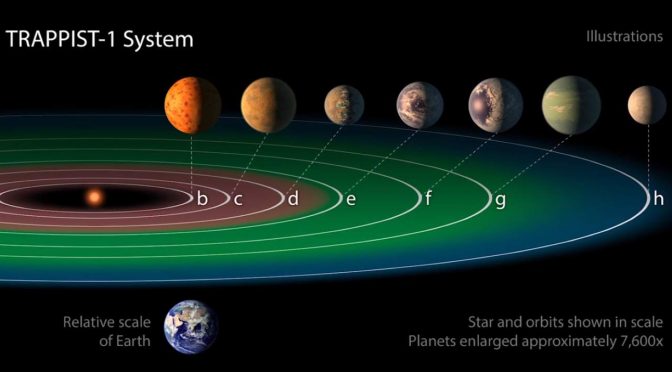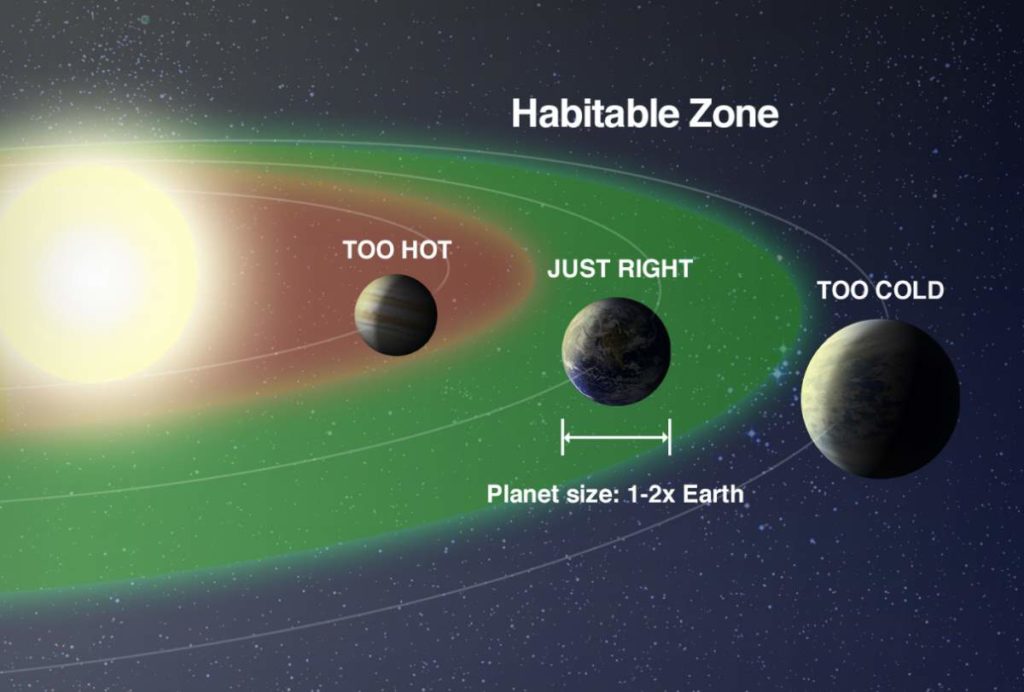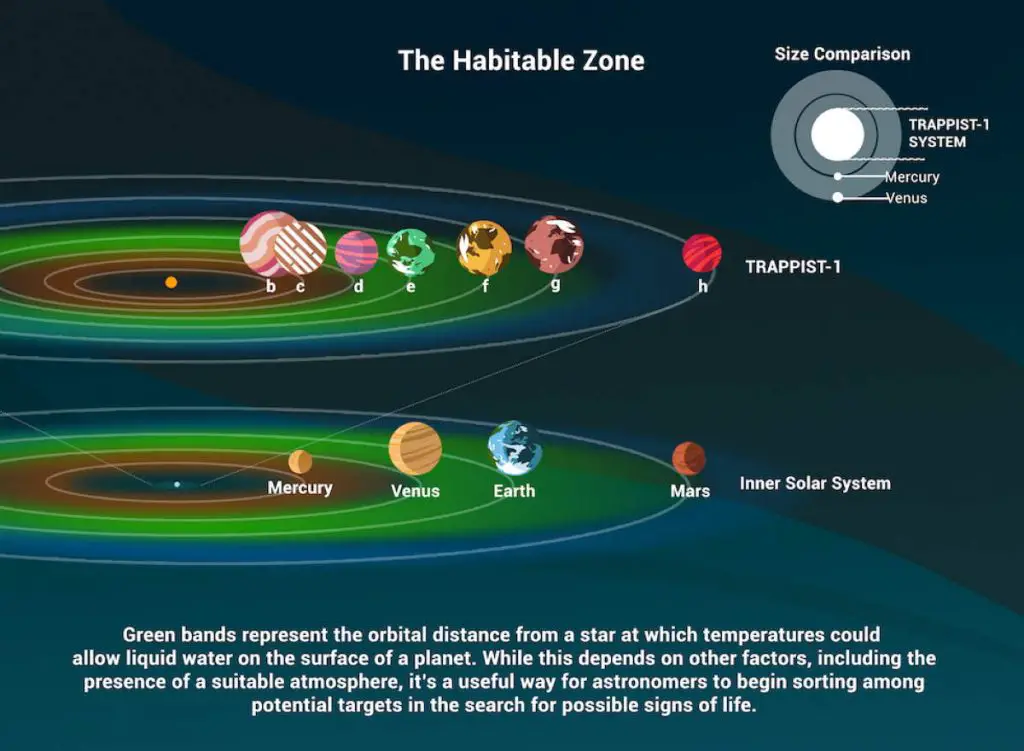Good news for the search for extraterrestrial life: the TRAPPIST-1 System might be rich (very rich!) in water and all of the planets are mostly made of rock. Using data from NASA’s Spitzer and Kepler space telescopes, researchers calculated the densities of TRAPPIST-1 planets more precisely than ever, and they determined that all of the planets are mostly made of rock. Additionally, some have up to 5 percent of their mass in water, which is around 250 times more than the oceans on Earth. Researchers published their findings in a recent study in the journal Astronomy and Astrophysics titled “The nature of the TRAPPIST-1 exoplanets”.
On February 22, 2017, NASA astronomers have announced that seven Earth-sized planets have been discovered around an ultra-cool dwarf star named TRAPPIST-1 which is located around 39 light-years from the Earth. The big news was: three of them were orbiting their star in the habitable zone. Astronomers and space enthusiasts were very excited by the discovery. But we can’t know for sure whether they could support life until we get more comprehensive observations of the system, including data on the planets’ atmospheres.
TRAPPIST-1 Exoplanets
According to the new study, “while the sizes of the TRAPPIST-1 planets are all known to better than 5% precision, their densities have significant uncertainties (between 28% and 95%) because of poor constraints on the planet’s masses”.
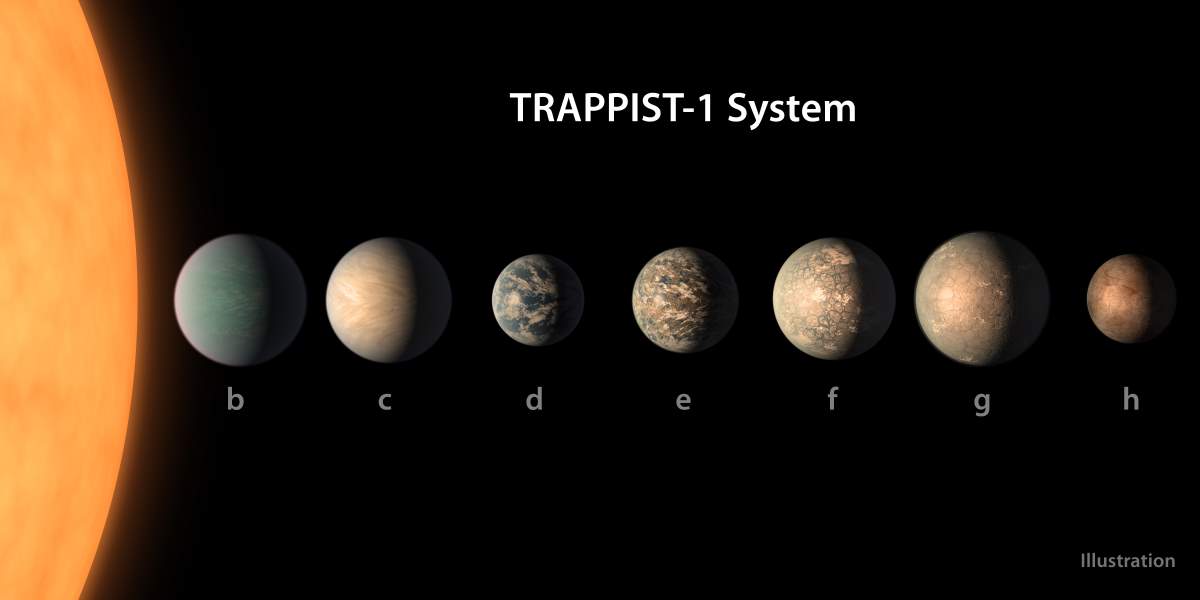
The goal of the study is to improve our knowledge of the TRAPPIST-1 planetary masses and densities using transit-timing variations (TTV) (see notes 1). According to the paper, the complexity of the TTV inversion problem is known to be particularly acute in multi-planetary systems (convergence issues, degeneracies, and size of the parameter space), especially for resonant chain systems such as TRAPPIST-1.
To overcome these challenges, researchers used a novel method that employs a genetic algorithm coupled to a full N-body integrator that they applied to a set of 284 individual transit timings. Using this approach, researchers efficiently explored the parameter space and derived reliable masses and densities from TTVs for all seven planets, with precisions ranging from 5% to 12%. Researchers found that TRAPPIST-1 c and e likely have largely rocky interiors, while planets b, d, f, g, and h require envelopes of volatiles in the form of
thick atmospheres, oceans, or ice, in most cases with water mass fractions less than 5%.
Ice, liquid of vapor?
Naturally, the form of water on TRAPPIST-1 planets would depend on how much radiation (heat) they receive from their star. The closest ones are more likely to host water in the form of atmospheric vapor, while those farther away may have water frozen on their surfaces as ice. TRAPPIST-1e is the rockiest planet of them all but is still believed to have the potential to host some liquid water.
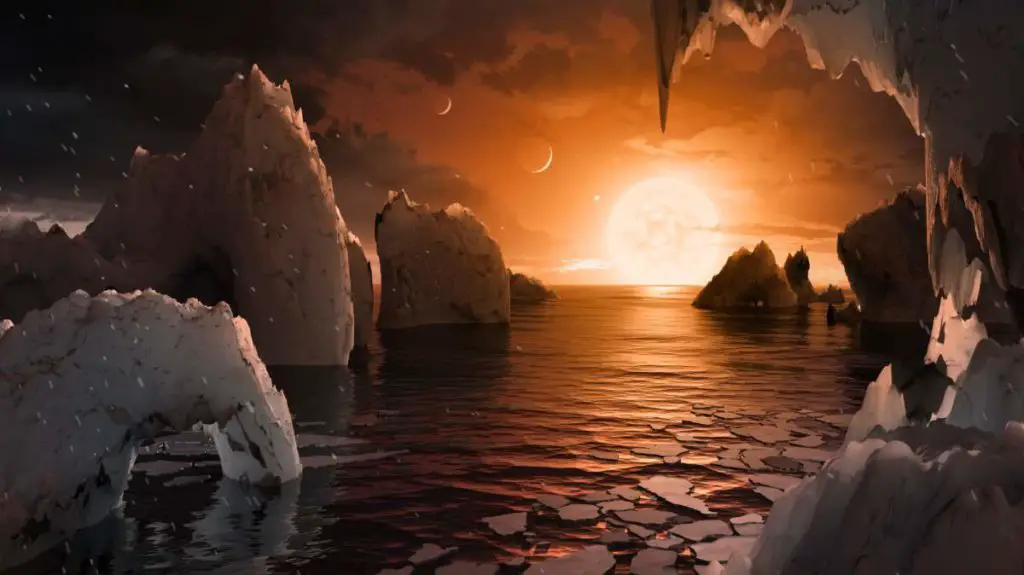
Related: TRAPPIST-1 System May Contain Water
Water is nice, what about atmospheres?
Using NASA’s Hubble Space Telescope, astronomers conducted the first spectroscopic survey of the Earth-sized planets (d, e, f, and g) around TRAPPIST-1, including three that are in the habitable zone (e, f, and g). Hubble reveals that at least three of the exoplanets (d, e, and f) do not seem to contain puffy, hydrogen-rich atmospheres similar to gaseous planets such as Neptune.
Additional observations are needed to determine the hydrogen content of the fourth planet’s (TRAPPIST-1g) atmosphere. Hydrogen is a greenhouse gas, which smothers a planet orbiting close to its star, making it hot and inhospitable to life. The results, instead, favor more compact atmospheres like those of Earth, Venus, and Mars.
As a planet in the TRAPPIST-1 system passes between us and the star, it blocks out a tiny portion of the star’s light. Precise telescopes like Hubble can look at changes in specific wavelengths of light, which provide clues to the composition and size of the planet’s atmosphere. Hubble observations in May 2016 of TRAPPIST-1 b and c showed that these planets do not seem to have thick, puffy hydrogen-rich atmospheres. This indicates a higher chance that they are rocky, terrestrial planets rather than mini gas giants.
These two planets are considered not in the habitable zone, though. Hubble then observed planets d, e, f, and g in December 2016 and January 2017 in near-infrared wavelengths, and the results were similar: Hubble found no sign of thick, puffy hydrogen-rich atmospheres for any of the four planets. The data suggest that there isn’t this gas-giant-like atmosphere for planets d, e, and f. The data from this round of observations was not as strong for planet g, which is also in the habitable zone like e and f, so while there’s no evidence for a thick, hydrogen-rich atmosphere on TRAPPIST-1g, the researchers are not yet ruling it out.
Planets e, f, and g orbit at distances where temperatures would allow for liquid water, while d is likely a little too hot because it is so close to the star. Hubble has yet to take observations of planet h, which is outside the system’s habitable zone (too far from the star). But it’s worth noting though, that even the planets outside of the habitable zone might be able to have liquid water somewhere on its surface in certain conditions.
It’s also worth noting that if any of these planets have high-altitude clouds and hazes, that would block Hubble’s ability to detect a tick, hydrogen-rich atmosphere, but such an atmosphere does not likely exist on these exoplanets. Many possibilities remain for what types of atmospheres these planets have, or whether they even have atmospheres. The TRAPPIST-1 planets could have compact atmospheres similar to Mars, Venus, and Earth, or something entirely different.
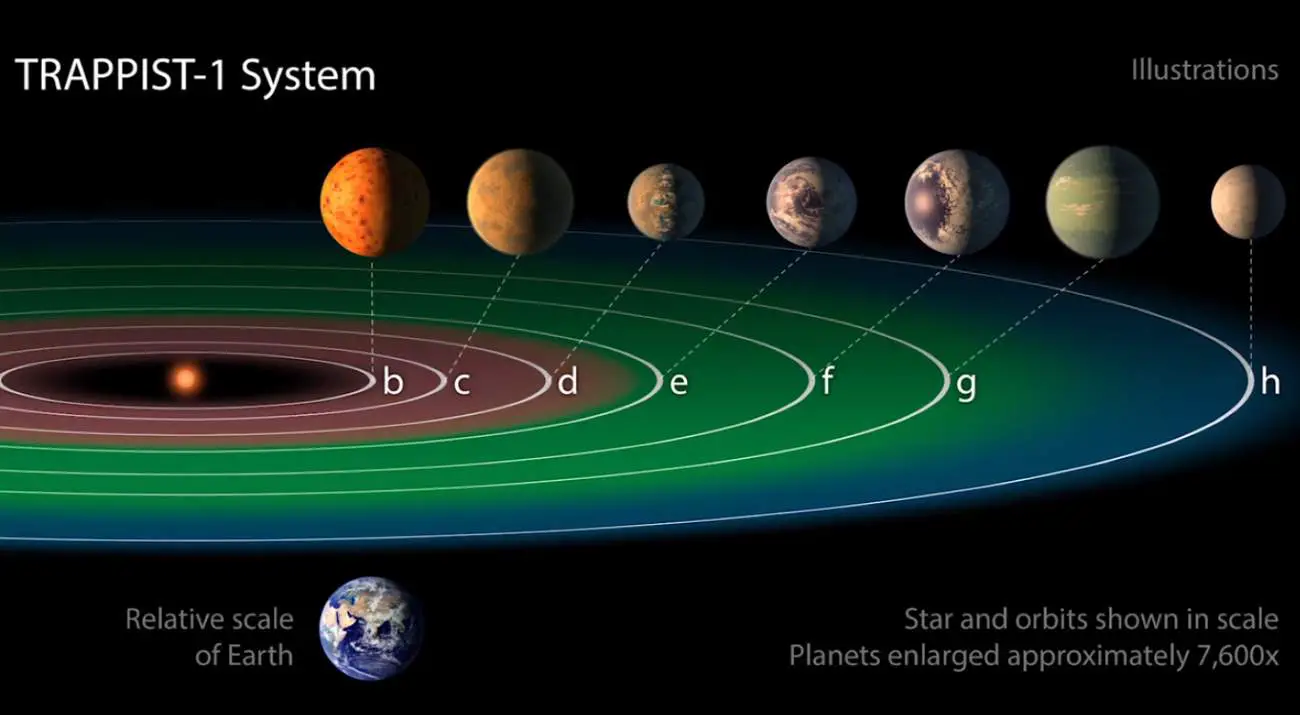
The combination of atmospheric gases is important. Find oxygen and methane in the same atmosphere, and you’ve got something special. There are ways to build up oxygen or methane in a planetary atmosphere, but the only way you get them both in the same atmosphere at the same time is if you produce them both super rapidly. And the only way we know how to do that is through life.
Researchers hope to use Hubble’s ultraviolet capabilities to look for evidence of water vapor or methane, and NASA’s upcoming James Webb Space Telescope will look in the far-infrared to further characterize these atmospheres.
Future telescopes also hope to look for hints of whether the planets are habitable and if life could be present. The TRAPPIST-1 system provides the best opportunity we currently have to study Earth-size exoplanets. Over the next few years, Hubble and other telescopes will work together, each contributing important observations. For the first time ever, we’ll have an in-depth understanding of a set of terrestrial planets outside our solar system.
Since Hubble’s observations in December 2016 and January 2017, NASA’s Kepler Space Telescope has also observed the TRAPPIST-1 system, and Spitzer Space Telescope began a program of 500 additional hours of TRAPPIST-1 observations, which will conclude in March. This new body of data helped study authors paint a clearer picture of the system than ever before.
What is TRAPPIST-1?
TRAPPIST-1 is an ultra-cool dwarf star, which is only about 9 percent as massive as our Sun. It is slightly larger than the planet Jupiter in size but has much more mass. It is located 39.6 light-years (12.1 pc) from the Sun in the constellation Aquarius. It was discovered in 1999 and astronomers first discovered three Earth-sized planets orbiting the dwarf star in 2015. On 22 February 2017, astronomers announced four additional exoplanets around TRAPPIST-1, and three of them were in the habitable zone.
Notes
- Transit-timing variation (TTV) is a method for detecting exoplanets by observing variations in the timing of a transit. This provides an extremely sensitive method capable of detecting additional planets in the system with masses potentially as small as that of Earth. In tightly packed planetary systems, the gravitational pull of the planets among themselves causes one planet to accelerate and another planet to decelerate along its orbit. The acceleration causes the orbital period of each planet to change. Detecting this effect by measuring the change is known as Transit Timing Variations (TTV). “Timing variation” asks whether the transit occurs with strict periodicity or if there’s a variation.
Sources
- New Clues to TRAPPIST-1 Planet Compositions, Atmospheres on NASA website
- Hubble Probes Atmospheres of Exoplanets in TRAPPIST-1 Habitable Zone on NASA.gov
- “The nature of the TRAPPIST-1 exoplanets”. A study published in the journal Astronomy and Astrophysics.
Transit-timing variation on Wikipedia- TRAPPIST-1 on Wikipedia
- How Many Elephants are Left in the World in 2025? - August 17, 2025
- Moon Landings: All-Time List [1966-2025] - February 2, 2025
- What Is Max-Q and Why Is It Important During Rocket Launches? - January 16, 2025
